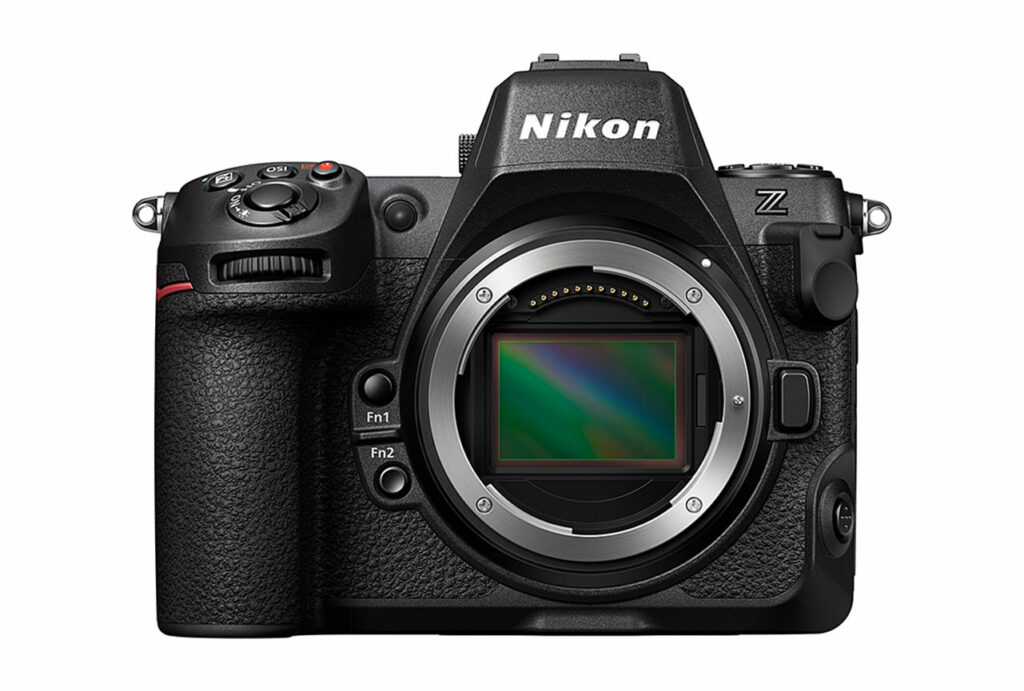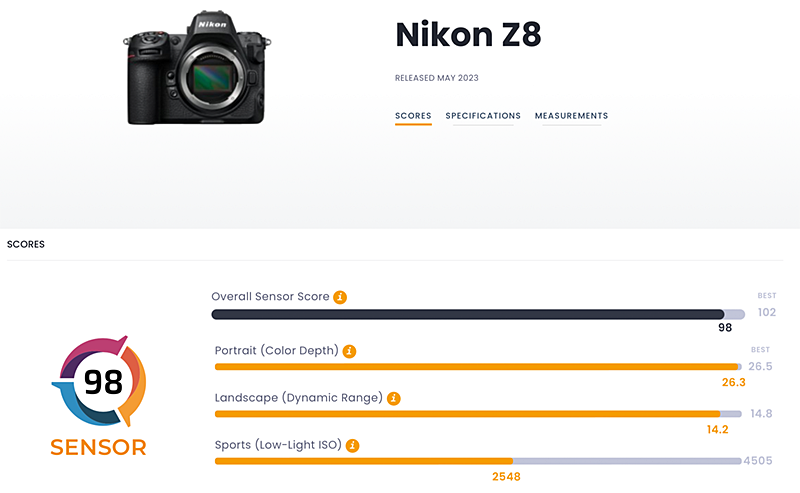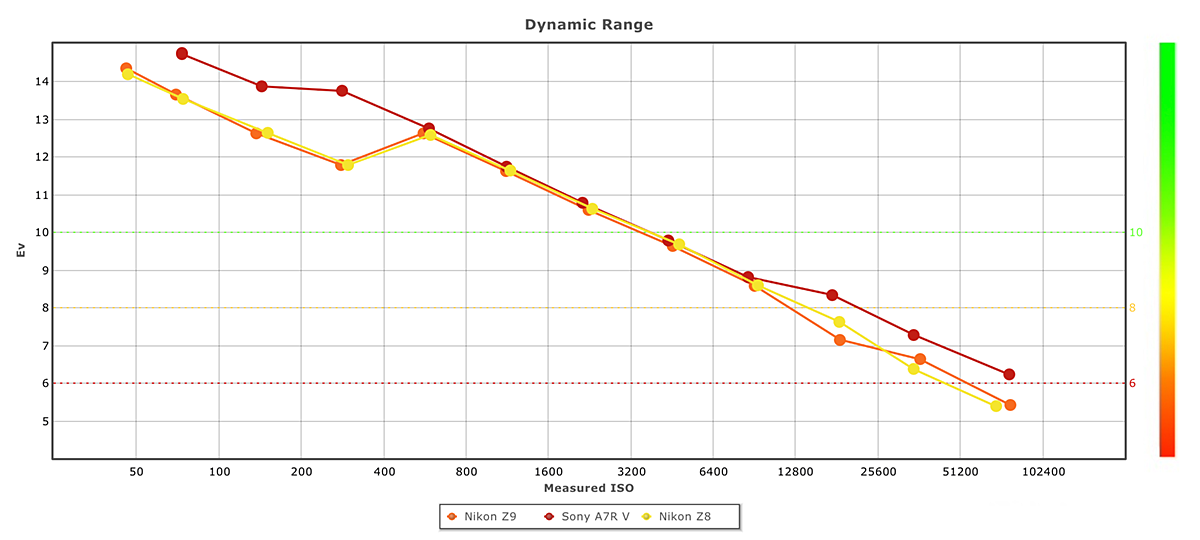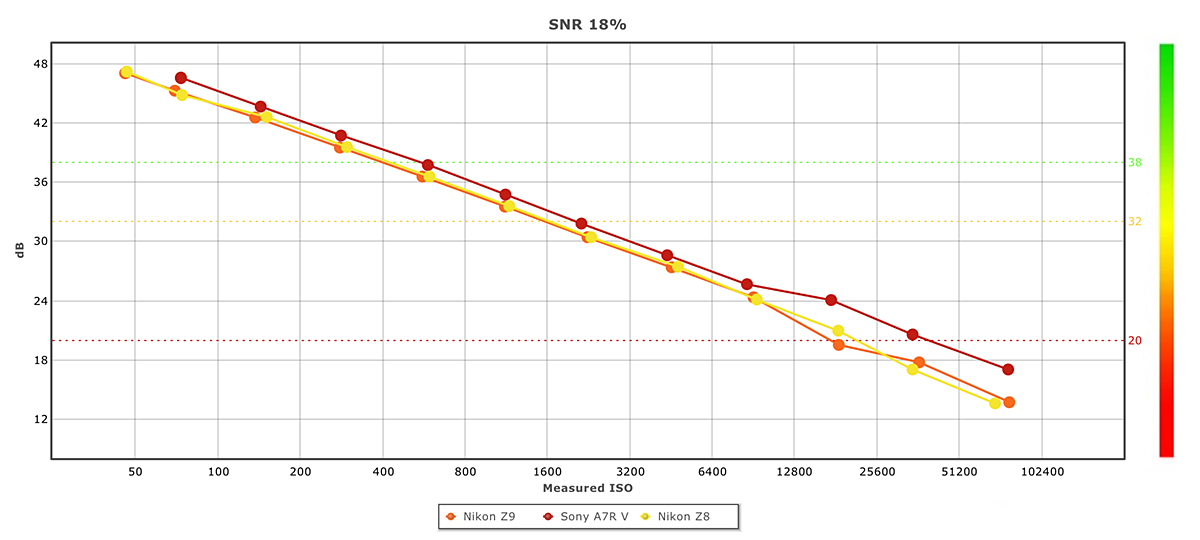The Nikon Z8 is the highly anticipated follow up to the Z9 pro-oriented mirrorless model using much of the same feature set but in a smaller, lighter body. Crucially, the Nikon Z8 adopts its sibling’s 45.7 MP “stacked” BSI CMOS type sensor and has a native sensitivity of ISO 64-256,000, with expansion to ISO 32-102,400.
Like the Z9, the Nikon Z8 eschews a mechanical shutter and adopts a totally electronic shutter instead, with shutter speeds running from 1/30,000 second to 30 seconds in Auto, down to 15 minutes in manual exposure mode. The Z8 also features the EXPEED 7 processor for a maximum burst rate of up to 20 fps in RAW and up to 30 fps in full-size JPEG, with both AE and AF enabled. A 120 fps burst option delivers 11 MP JPEGs.
Further features include an advanced AI-powered AF system that includes subject detection and tracking in stills and video and in low light levels (down to -9 EV). It also has the same “black-out free” 3.69 m-dot OLED electronic viewfinder (EVF) and a 3.2-inch four-axis, tilting touchscreen display. In-body stabilization of the Z9 features of course and offers the same, up to 6 EV, compensation with supported lenses.
The Nikon Z8 also inherits impressive video capabilities such as full-width 8K/60p and oversampled 4K up to 120p, plus 12-bit N-RAW and 4K ProRes RAW options.
Finally, the Z8 has two card slots (CFexpress Type B & SD UHS-II) and a host of connectivity options including Wi-Fi (2.4/5GHz), full-size HDMI, Bluetooth LE, and two USB-C 3.2 (Gen 2), allowing charging with one and tethering or file transfers with the other.
The Nikon Z8 is available now for $3,997/€4,799.
Key specifications
- 45.7 MP full-frame stacked CMOS sensor
- Native ISO 64-25,600, with expansion to ISO 32-102,400
- 20 fps (RAW), up to 30 fps (JPEG)
- 493-point phase-detection AF system
- 3.69 m-dot OLED electronic viewfinder (EVF)
- 3.2-in 2.1 m-dot quad-tilt TFT-LCD
- 8K/60p, 12-bit N-RAW, 4K (oversampled)
- Sensor shift, up to 6 stops compensation
- Two card slots (CFexpress Type B, SD UHS-II)
- WiFi (2.4/5GHz), Bluetooth LE connection, USB-C (3.2), HDMI (Type A) connectivity
Overall performance
Click on the score chart above to open the Nikon Z8 product page.
The stacked full-frame BSI CMOS sensor in Nikon Z8 achieved a high DXOMARK score of 98 points. As you might expect, that sets the new Nikon mirrorless hybrid alongside its sibling the Nikon Z9, as well as the 50 MP Sony A1, which also features a stacked BSI CMOS sensor, ranking jointly in 6th place for all sensor sizes, including 44x33mm medium format. Other high-performing sensors around the same DXOMARK score include the Nikon D850 DSLR, Sony A7R V, Nikon Z7 II and Leica M11 at 100 and the 60 MP Sony A7R IV at 99 points. While still very close but a little under the Z8 is the Canon EOS R5, which achieved 95 points.
As for the individual scores, the Nikon Z8 sensor achieves a strong response for color depth at base sensitivity (ISO 64) measuring 26.3 bits, falling to 14 bits at ISO 25,600. The sensor also has a wide dynamic range with a maximum of 14.2 EV at ISO 64. In the Sports (low-light ISO) category – calculated from specific minimum values of SNR, color depth and DR – the Z8’s sensor response isn’t quite a match for the sensitivity of the best low-light performers at ISO 2548.
In-depth comparisons
While the Nikon Z8 sensor is geared towards phenomenal speed, boosting AF operation, burst rate and that “blur-free” viewfinder display, the smaller body and hugely competitive price will prove attractive to an ever wider range of photographers. The tempting price means it compares comfortably with the $4,000 60MP Sony A7R V, rather than the Sony A1, which is priced at an astonishing $6,000. Admittedly the Sony A1 is closer in outright capabilities, but we’ve already contrasted it with the Z9, so it makes more sense to base the comparison of a rival on price.
That said, we’ve also pitched the Nikon Z8 against the existing Nikon Z9 flagship, instead of the more obvious candidate, the around $4,000 Canon EOS R5. That way we can see if the Z8 really uses the same sensor as the Z9 and, if it is, as seems most likely, if there’s any change in the signal processing. Curiously, the attractive pricing of the Z8 means the Nikon Z9 comes with a premium of around $1,500, seemingly making it another competitor for consumers’ hard-earned cash.
Portrait (color depth)
Like the Nikon Z9 before it, the Z8 sensor has excellent color fidelity at base sensitivity, with a maximum color depth of 26.3 bits at ISO 64. The sensor’s genuinely lower native base of ISO 64 (measured at ISO 47) as opposed to the more usual ISO 100 base of the Sony A7R V helps here. We don’t want to speculate but it’s more likely from a denser, more pure color filter array than the sensor architecture. Still, it’s interesting to note that when all three are at the same ISO 100 setting, the response of the Z8 and Z9 drop fractionally beneath the Sony. Indeed between ISO 100-400 and then at ISO 25,600-102,400, the Sony A7R V has a better color response of around 1 bit over the Nikon Z8 and Z9.
Landscape (dynamic range)
The Nikon Z8 also has excellent dynamic range at base (ISO 64), measuring just over 14 EV (14.2 EV) at its widest. However, the A7R V already has a slightly better response at ISO 100 measuring 14.8 EVs. What’s more, the Nikon Z8 and Z9 sensors’ dynamic range declines at a typical 1 EV per 1 EV change in ISO sensitivity from a lower starting point (base ISO) through ISO 400, where it measures just under 12 EV (11.78 EV). It’s not until the second gain is applied between that and ISO 800 that results in an uplift in DR back up to the ISO 200 level, at around 12.5 EV (12.6 EV).
While that’s still a very respectable result, Sony on the other hand has a slightly different strategy. With the A7R V, the second sensor gain is applied a stop (1 EV) earlier in ISO sensitivity, between ISO 200 and ISO 400. With a 1 EV advantage already in DR at ISO 200, the Sony A7R V accrues almost +2 EV over the Nikon Z8 and Z9 at ISO 400. Despite that significant difference, at ISO 800 all three have more or less the same 12.5 EV dynamic range and the response is similar at higher sensitivities. While the Nikon Z8 and Z9 sensors perform practically identically we measured a +0.48EV uplift in DR in the Z8 at ISO 25,600. It is, however, short lived as by ISO 51,200 and above it has dropped slightly below the Z9. Interestingly, the Sony A7R IV also shows an uplift in DR at the same sensitivity, ISO 25,600.
Sports (low-light ISO)
In the low-light test, we calculate the highest ISO setting that results in a minimum quality standard, which is based on an SNR of 30dB while maintaining a dynamic range of at least 9 EV and an 18-bit color depth. Against this criteria, the difference between the Nikon Z8 and Z9 is negligible (+0.04 EV). However, using the same benchmark, the Sony A7R V sensor has a significantly better response, in terms of measurement anyway, and is nearly +0.5 EV more sensitive than the Nikon Z8 and Z9.
Conclusion
Nikon calls the Z8 the “successor” to the D850, and it’s not so difficult to see why. Although there hasn’t been an increase in pixel count — the 45 MP to 47 MP range seems to be the current sweet spot — the Z8 is an immensely versatile and flexible camera. While the speed advantages of a stacked CMOS are clear, image quality is also excellent. Anyone contemplating the switch from DSLR to mirrorless will discover the Nikon Z8’s performance compelling. This, combined with the tempting price and more portable form factor over the Z9, makes the Nikon Z8 a hugely attractive option for a wide range of photographic tasks.
In this review, we have mentioned the Nikon Z8’s most relevant rivals from other brands. As usual, you can compare it with these and with other models and create your own comparisons and in-depth analyses using our interactive image sensor ranking tool.









DXOMARK encourages its readers to share comments on the articles. To read or post comments, Disqus cookies are required. Change your Cookies Preferences and read more about our Comment Policy.